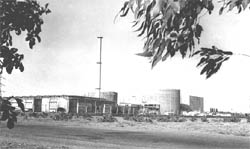Impaired hearing
 india's first public hearing on the effects of a nuclear installation in Kanchipuram near Kalpakkam, Tamil Nadu, on July 27, 2001, was a statement on how the country's nuclear establishment is run. The hearing was held for the controversial prototype fast breeder reactor ( pfbr ), which is to be set up in Kudankulam near Kalpakkam.
india's first public hearing on the effects of a nuclear installation in Kanchipuram near Kalpakkam, Tamil Nadu, on July 27, 2001, was a statement on how the country's nuclear establishment is run. The hearing was held for the controversial prototype fast breeder reactor ( pfbr ), which is to be set up in Kudankulam near Kalpakkam.
Local residents and anti-nuclear groups oppose the pfbr for two reasons: the technology has proved to be unreliable worldwide, and thus poses serious threat to the local ecology and human population, particularly when the region is already cramped with nuclear complexes.
The pfbr will be built by the Indira Gandhi Centre for Atomic Research ( igcar ) at a cost of Rs 30 billion with assistance from Russia. Kalpakkam already has two operational reactors run by the Madras Atomic Power Station (maps ) and many nuclear research facilities. Local residents allege that the existing nuclear reactors have already affected the local ecology and human health. And adding another one will spell doom.
Preceded by high-pitch campaigns by both the igcar and the anti- pfbr groups and a postponement, the hearing saw local farmers and fisherfolk narrating the impact of the present reactors on their local ecology. Out of the 100-odd local residents present, 50 spoke on the occasion, but none favoured the project. Local people representatives attended the hearing and barring a single councillor, all opposed the pfbr . The local member of legislative assembly, Phirukka T Arumgan, opposed the project saying that the nuclear establishment has not been able to protect people from the hazards of nuclear reactors.
Osi Fernandes of Coastal Action Network ( can ), an organisation leading the movement against the pfbr , said, "The pfbr is an obsolete technology. It has been phased out in France and usa ( see box ).' Ironically Russia, which is assisting India for the pfbr has abandoned fast breeder reactors due to numerous accidents. India's pilot fast breeder reactor built 15 years ago also faces numerous technical problems and never attained its capacity for more than 53 days at a stretch. Ironically, the proposed pfbr is designed on the basis of this pilot reactor.
As the high-level igcar officials remained mute spectators, the fisherfolk came out with evidences to show the effects of the nuclear complex. According to them, marine fauna in the area had declined due to hot water and radioactive discharge from the reactors of maps . The pfbr will also discharge millions of litres of such water everyday into the sea. Moreover, there is additional water discharge during its periodic shutdown every eight months to download spent fuel from the reactor.
According to the fisherfolk, fish catch has gone down drastically, thus leaving many of them impoverished. Also many species of fish and prawns are no longer available. Local estimates show that fish yield from the Kalpakkam coast was 1,171 tonnes before the reactors were established. Now it has come down to just 274 tonnes. The can claims that jellyfish population had increased due to the high salinity in the water. "These creatures breed where temperatures are high and the temperature of the water at the Kalpakkam coast has increased considerably since the maps and the igcar research reactors started operations,' says Jesu Retinam of can.
Activists say that health hazards due to the reactors are now coming to light. As India's nuclear establishment never makes its health survey public, a group called Doctors for Safe Environment ( dse ) carried out a health survey of Kalpakkam's villages and found widespread deformities. R Ramesh, a doctor and a member of dse , says that the survey revealed an increasing incidence of polydactylism . "This is a phenomena where people are born with six or more fingers. This may have been as a result of the increased radioactivity in the local environment,' says Ramesh.
Interestingly, in 1997-98 the igcar commissioned a cancer screening survey of the local area by Tata Memorial Cancer Research Hospital and the regional cancer research centre. But the findings of the survey were never made public. In its defence, the atomic department put forward its environment impact assessment report ( eia ) conducted for the pfbr project, which gives the igcar nuclear complex and the pfbr a clean chit. The eia has now become the bone of contention between the atomic energy department and the anti- pfbr groups. Experts believe that the eia has been engineered and doesn't reflect the real picture. "The document is not something to rely upon as it fails to assess the most important aspect of a nuclear installation, the hazard to human health,' says Ramesh who has recently published a critique of the eia . Analysis of the data given in the eia , says Ramesh, shows that radioactivity level is increasing, but does not say it is due to pfbr .
After the public hearing the district authorities may have submitted a report to the Union ministry of environment and forests for final clearance. Notwithstanding a pending clearance, the nuclear establishment is confident of the outcome. Immediately after the hearing the igcar director S B Bhoje declared, "The new reactor would be installed in December 2001.
Related Content
- Rising vehicle population a threat to your eardrums
- ‘60% of hearing loss cases avoidable’
- Effect of cigarette smoking and passive smoking on hearing impairment: Data from a population–based study
- Supreme Court admits EPCA report on priority measures to control air pollution
- Survivors protest on 19th anniversary of Bhopal gas tragedy
- Effort to ’Go Green’ reaches children of lesser gods
